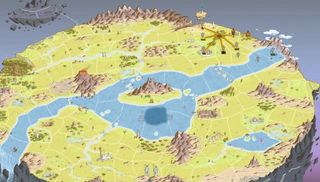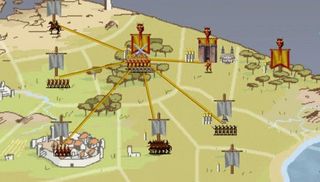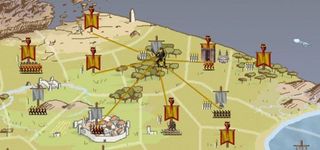Dominions diary part one: gods go to war

Welcome to part one of PC Gamer's Dominions 4 diary. For the rest of the story check out parts two and three.
1. Play as an obelisk.
2. Destroy all other gods.
3. No blood magic.
Dominions 4 is a turn-based strategy game about warring gods. Each deity commands a nation of beings ready to fight and die to secure their lord's ascension, and each is borrowed from recognisable mythology. Greek centaurs battle the dark creatures of Nordish Helheim. Atlantean troops wrestle with the Lovecraftian beasts of R'lyeh. It's as though a literature professor and a history professor got drunk together and started asking “who would win in a fight between this ancient cultural belief and that dark fantasy monster?” And then made a game to find the answer.
There are dozens of nations, and even more types of god. The warring deities aren't invisible, hands-off types, either. They have corporeal forms and abilities that you define for yourself at the game's outset. Your god can be a dragon that excels in fire magic, or a giant white bull that happens to be an expert necromancer. One of the godly forms you can use is simply a pile of haunted old bones. The form the god takes informs its stats, magical ability and how it moves around.
I'm going to win Dominions 4 as a giant stationary hunk of rock. Or try to, anyway. I could have been a monster riding a giant grey ape. I could have been one of three dragons. I could have been lots of things, but none have the charm and comedy sprite of the noble, silent obelisk.
But what race to choose? Barbarians? Boring. Giants? Boring. No, I shall play as the Lanka, a race of apes ruled by a race of demonic ogres, now also ruled by an inanimate slab. The apes will be the fodder, the ogres will be the shock troops, and I'll find plenty of use for the Lanka's reasonably competent ogre mages.
As well as fighting, the gods can research and cast magic, and spread influence across the land. That influence is your dominion, a series of traits that terraforms nearby territories making them hotter or colder, more ordered, richer, poorer or more prone to bad luck. This, too, is designed by the player, which means I have some decisions to make. I'm dropping into a map with seven other, AI-controlled, gods, and will have to destroy every one of their territories to win. Let the ascension of Balboa commence.

You define your god and dominion by spending points on attributes. My point pool is shallow to begin with, but I can afflict my dominion with negative statuses to grow it. I've decided that given my superbeing can't move off one spot, I'd better get good at long-range magic. I add a few points to improve the rate of magical research in my realm, and then boost productivity to ensure a steady stream of riches. To squeeze out a few more points, I inflict misfortune upon my dominion, which means more random events. I also increase my dominion's 'turmoil', which will cause more uprisings, diseases and other nasty occurrences. I'm an angry god.
The biggest gaming news, reviews and hardware deals
Keep up to date with the most important stories and the best deals, as picked by the PC Gamer team.
There are two upsides to this act of sabotage. Dominion affects nearby enemy provinces, and can be spread further with temples and prophets. I'll be radiating bad karma into my enemies' lands as I approach for an attack. The second bonus: I can put lots of points into making my god a master of death magic. Magic gets incredibly powerful toward the endgame, and necromancy will eventually let my obelisk raise armies several provinces away.

I have one last trick to pull before the great war begins. I make my god dormant. That means he won't enter the game until he awakes at some point a couple of gameyears into the war. That sacrifice gives me even more points to spend on death magic. I also boost the potency of my dominion's influence, hoping that it'll overwhelm the weaker presence of competing gods.
It's on. I start the game with a single province at the north-eastern rim of a giant disc of land floating in space. You can randomly generate maps, but this one, Valanis, has been hand-crafted. I haven't played it before, but the designer's touch will ensure that none of the eight factions get unfairly isolated by too many rivers and mountain ranges.
I have no god in play, but I do have a huge armoured ape with a scimitar. He's a Bandar Commander, and I need to quickly build him an army and take as many provinces as I can before I bump into one of the seven other mystery factions. I build him a bunch of Bandar Light Archers (apes with bows), and then recruit some Palankasha. These sacred demon ogres eat twice as much as other units, but have the 'head and legs of a tiger and the body of a muscular man with ape-like arms', and will make fine shock troops. They're strong, revered by apes, and become more powerful in dominions with high turmoil. They'll thrive in my domain.
After a turn we enter late spring in the first year of the ascension wars. Four of the seven gods have named prophets, revealing their identities right away. One of them is R'lyeh, who will probably spend most of the game confined to the sea. Helheim are in play, which means flying Valkyries and powerful air and death mages. Pangaea is a 'woodland realm of wild halfmen' who also recruit annoying satyrs. Finally, C'tis, a nation of tough lizard people who ride chariots. Three of them are good at death magic. We're going to see a lot of necromancy before this thing is done.
I have no prophet, but that's about to change. I've recruited a Raksharaja, a king among demon ogres, who are themselves kings among the giant ape people. Lankan politics is complicated. The important thing is that Adra the Raksharaja—a 'formidable warrior' and 'leader of the Lankan Demon Cult'—is a brilliant researcher and a good leader. My god is still enjoying a lie-in, so currently he's the strongest thing in my kingdom. I name him as my one and only prophet. He will spread my dominion's influence wherever he goes.

Adra gathers up troops and starts claiming nearby provinces. Every province is full of independent armies, so you're always fighting to carve out territory. It's good early experience for Adra. He defeats some indigenous lizard men and devastates a small army of Jaguar Tribe warriors. He barely takes any losses in his first campaign. The ogre's got talent.
A couple of turns later an 'unexpected event' occurs. A slave ship has been discovered in some highlands just north of Lanka. I'm told that the cargo has been confiscated and 'several virgins were transported to your blood-slave dungeons'. Wait, what? I have blood-slave dungeons? How do I have blood-slave dungeons?
It occurs to me that as the leader of a race of demonic ogres who practise death magic, I am almost certainly the bad guy in this scenario. Phrases like 'leader of the Lankan Demon Cult' should have clued me in, I admit. I'm not really into the bloodslave virgin capturing thing (I'll stick to raising the bodies of the deceased, thank you very much). Sadly, there seems to be no way of releasing my captives, unless I magically distil them into gold, or death gems. Is that worse? That seems worse
Another prophet is declared! Oh great, it's Mictlan, crazy hungry god obsessed with blood sacrifice. The very next turn, my prophet Adra explores the northern province of Tenvir and finds The Slaughterhouse, a facility that promises to supply me with three blood-slaves per turn until the end of time. Why is everything suddenly about blood-slaves? I don't want blood-slaves. Even though my demon ogres can use blood magic, under my orders they never will. In fact, these slaves are much safer with me than they are with Mictlan. In a way, I'm keeping them safe. Sort of. Who knows, perhaps the blood-slave dungeon is just one of those places that sounds horrible, but is actually sort-of-OK, like Hull.
Having successfully rationalised myself out of a deepening guilt-funk, I turn my attention back to the total destruction of every other sentient being in Valanis. Adra charges westward, having briefly stopped at the capital to pick up some spare ogres. I'm cut off from the south-eastern quarter of the disk by a single river crossing. On the other side I can see the flag of another god's dominion. It's C'tis, the lizard people. They don't seem interested in crossing the bridge yet, and I'd rather not brave the choke point without a vast army in support.
Something weird happens in my recently captured province of Monherboa. A wave of 'religious zeal' has swept through the local monkey populace, and 'a chittering group of the annoying creatures' is available to fight. 'Group' makes it sound small. It's a 70-strong throng of tiny rubbish monkeys. They're 'undisciplined', which means they can't be given battle orders, but they'll make an excellent frontline fodder-blob. I assign them to my second general, another demon ogre king called Ahar, tripling the size of his force.
“The entire nation rejoices!” blares a message. That can only mean one thing: my god has finally arrived. “Balboa, God of Lanka, the One Always at the Shoulder, master of Many Names, The Shadow Over All, the Far Traveler has awakened.” I call him rocky Balboa, for short. The list of titles is randomised, but I decide to build up a series of affixes as the campaign continues. So far, it's Balboa, Reluctant Confiner of Blood-Slaves. I imagine the apes dancing in joy at the obelisk's arrival. I have accidentally recreated the start of 2001: A Space Odyssey.
With my god in play, I can start doing some serious magic research. There are seven schools to choose from, containing hundreds of spells between them. Balboa hits the books—somehow—and starts levelling up my dominion's Enchantment level. That'll let me summon powerful beasts such as undead kings and Behemoths—basically undead mammoths.
Meanwhile, a pair of Ettins have started eating commoners in Monherboa, perhaps encouraged by the 70 religious monkeys that left the province for a life of action a few turns ago. My second general, Ahar, leads his army back to put the Ettins down. The Ettins eat three tiny monkeys before being overwhelmed.
Then a worldwide event occurs. “The stars are right for blood magic.” This game is trying really hard to tell me something, but no. I will not sacrifice a single blood-slave for weird blood magic purposes. That is a vow. Not going to happen.
I can't help but sneak a look at the blood magic spell tree, however, to see what I'm missing. There's Infernal Prison, which sucks a target into an inferno full of devils that ensures 'certain death for most mortals'. Not bad, but there's also Bind Demon Lord, a spell that shackles a monstrous infernal ruler with powers 'shrouded in mystery'. I'm starting to see why these could be useful. But no! I must be strong. It is time to close this grimoire and take another turn. I at least have an idea of what I can expect when I eventually meet Mictlan.
I build a couple of fortresses. They take five months to build, but can be garrisoned, and can produce troops that change based on the hosting region. To my delight, Adra throws up a fort in Doven that can recruit war elephants. My head fills with visions of an army made up of war elephants and undead mammoths. I resolve to build more mages as soon as I've reinforced my armies to make this vision a reality. I plan to recruit dozens of mages, all researching, all the time. If I get to Dominion's top spells first, I'll have a huge advantage.
I'm starting to feel the negative effects of turmoil in my realm. A famine strikes one province, killing 1,320 and increasing unrest, then people start worshipping false gods in another area, reducing my dominion's influence there. In the province of Escuania, warring tribes cause unease and kill 140 onlookers. That's all OK though, because an unexpected event has occurred in Lanka. “Your commander has befriended a stray dog.” In spite of his hard, completely impassive face, Balboa, Reluctant Confiner of Blood-Slaves has a soft side.
Meanwhile, my generals take more provinces to the west, and finally meet resistance. My prophet Adra encounters some large independent armies in the northern provinces, while Ahar presses on to the centre of the map. My generals are divided by a river cutting horizontally across the northern half of the disc, which means they can't reinforce one another. That makes me nervous, especially when I see the pale turquoise flags of another god's forces to the north. It's Mictlan, with armies of slaves and blood warriors.
Things get worse when general Ahar reaches a bridge, and spots a huge army sporting the dark green flag of Pangea. It's the halflings. They've recruited a massive force of wolves, harpies and centaurs to cross the river. A few provinces away, war elephants are being recruited by the half-dozen at Doven and I'm about to research some dangerous magic.
So far I've secured a sizeable foothold in the world with a mostly-absent god. Now I'm about to clash with the other pretenders in a war on two fronts. The battle for Valanis is about to get serious.
In part two: WAR and MORAL DILEMMAS and a small dog.The story concludes in part three.
Part of the UK team, Tom was with PC Gamer at the very beginning of the website's launch—first as a news writer, and then as online editor until his departure in 2020. His specialties are strategy games, action RPGs, hack ‘n slash games, digital card games… basically anything that he can fit on a hard drive. His final boss form is Deckard Cain.

If you love big trucks, establishing trade routes, and the phrase 'post-apocalyptic survival business simulator' then I've got just the strategy RPG for you

Blizzard veteran David Kim's strategy comeback with Battle Aces is 'very personal:' 'I just can't accept... the end-all peak of RTS is StarCraft 2 and nothing can ever be better'
Most Popular





